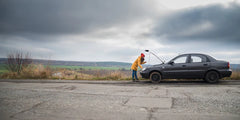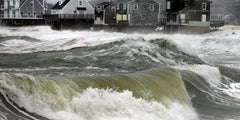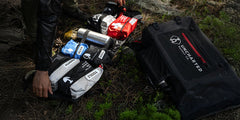
You’re driving down a lonely road in the middle of nowhere. All is going well. It’s nippy outside, but your heater is doing just fine. There are a few suspicious truck drivers on the road, but you’re whizzing right by them. You have no idea where you’re going, but you’ve got your cell phone’s navigation system guiding you.
And, then, the engine sputters a few times. Thumps and lugs shake your vehicle. The car slows to a crawl, and then it stops outright. There’s smoke rising from your hood.
It’s getting dark. The cabin is getting colder. Your cell phone is now running on its own battery, which has seen better days. And those scary truck drivers are catching up to you…
This is a common nightmare for lots of drivers. Thankfully, there are two reasons why you don’t have to panic. First, not all truck drivers are mean and scary. Second, you can easily avert roadside emergencies simply by having an emergency car kit—also known as a roadside emergency kit.
Car Emergency Kit Checklist
So, you roll out of bed panting and drenched in sweat, having woken up from that horrid nightmare. “What should I have in my emergency car kit?” you wonder.
An emergency car kit should have equipment that will help you in any situation where a malfunctioning vehicle puts you in a life-threatening or harmful situation. Most of the time, people use emergency car kits when their vehicle breaks down, and they’re left stranded in a harsh environment with no access to food and water. There are ten essential items you should keep in your car emergency kit:
- First Aid Kit
- Portable Jump Starter
- Flashlights and Visibility Items
- Flat Tire Kit
- Tow Straps
- Fire Extinguisher
- Water and Non-Perishable Food
- Multi-Tool
- Navigation Equipment (compass, GPS, etc.)
- Climate-Control Equipment (warm weather/cold weather apparel, fans, blankets)
These 10 items serve two purposes. First, they’ll help you get your vehicle back in working order if the damage isn’t too severe. Second, they’ll help you stay alive until you can get your car started, or until help arrives.

Breaking Down Your Emergency Car Kit
Let’s review each of the 10 items you should have in your emergency roadside kit.
1. First Aid Kit
Every emergency kit needs a first aid kit. There are plenty of first aid kits out there. You can buy one at the store, or, you could assemble your own first aid kit if you prefer to select your favorite brands of bandages and painkillers. Either way, a good first aid kit should have:
- Band-Aids
- Gauze Pads
- Hand Sanitizer
- Anti-Bacterial Wipes
- Aspirin
- Cotton Balls
- Tweezers
- Sunscreen
- Bug Spray
- Splints
- Bandanas
Lots of people have the impression that first aid kits only treat very minor injuries. “I can just ‘tough out’ a small injury, so why do I need a first aid kit?”
You’ll never know what kind of injury you may sustain in a roadside emergency. You could cut yourself badly while you’re working on your car engine, or you could suffer fractures if your vehicle strikes something. First aid kits have materials that can treat both mild and more severe injuries. You can use first aid kits to alleviate symptoms and prevent infections until you’re able to get professional medical care.

2. Portable Jump Starter
Many broken-down vehicles won’t start for one reason: the battery has died. There are lots of reasons why your battery might have died, but most of the time, it died because the electricity or air conditioning was left running after the engine was shut off. If that’s the case, you can always restart the battery by using jumper cables.
The problem with jumper cables is that you need a second vehicle to use them. If you’re going to be driving in a secluded area where there are few passing drivers, a jumper cable won’t help you very much. Even when there are plenty of other drivers, you shouldn’t have to rely on other people when you don’t have to (remember those scary truck drivers in your nightmare?).
Use a portable jump starter instead of jumper cables. It’s essentially a portable battery that you can use to jump start your car without a second vehicle or a second person. It’s the fastest, easiest way to restore electric power to your vehicle.
3. Flashlights and Visibility Items
It’s possible that you have a roadside emergency at night. Or, your vehicle could break down somewhere where there’s little sunlight, like a forest. It’s important to have lighting equipment for those situations.
A flashlight is a necessity if you’re going to do work on your engine. Even when you’re in broad daylight, the engine of your car has lots of dark nooks and crannies that can be difficult to see without additional illumination. When you have a flashlight, you don’t have to turn on the lights inside your car and risk draining your battery.
You should also have additional forms of illumination that will keep your car visible if you’re stuck on the roadside at night. You don’t want to get struck by another vehicle that can’t see you in the darkness. Glow sticks are the easiest way to alert other vehicles to your presence. Place glow sticks on each corner of your vehicle to make it more visible in the darkness.
4. Flat Tire Kit
A flat tire kit is your second “kit within a kit.” A flat tire kit consists of four tools that will help you swap out a flat tire:
- Jack
- Lug Wrench
- Vehicle Owner’s Manual
- Spare Tire
The vehicle owner’s manual will alert you to any idiosyncrasies to watch out for when you’re changing the tires of that particular vehicle. Most vehicles come with a spare tire and tire-changing equipment. But if you’re missing any of those items, be sure to get them and include them in your roadside emergency kit. See this quick guide on how to change a tire if you don’t know how to do it.
5. Tow Straps
Tow straps are very important, but they’re often overlooked. If your vehicle gets stuck in the mud or in a ditch, you can attach it to another vehicle via heavy duty tow straps and have it tugged back onto the road. In this scenario, you might appreciate the assistance of a scary truck driver and his big ol’ 10-wheeler.

6. Fire Extinguisher
Most emergency kits don’t require a fire extinguisher, but you should always have one in a roadside emergency kit. One of the most dangerous vehicle situations is when your engine or cabin interior catches fire. If your car catches fire, speedy use of a fire extinguisher could save your vehicle.
When you notice that your car is burning, immediately stop the car so long as it’s relatively safe to do so. Exit the vehicle, while being mindful of oncoming traffic.
Here’s where you’ll need to make a judgment call. If the fire is only a small flame, and you think you can retrieve the fire extinguisher from the emergency kit and quickly put out the flame, do so. But if the fire is already very large, and especially if the engine is on fire, it’s better to get as far away from the vehicle as possible.
Burning vehicles may explode. It’s important that you get as far away from the burning car as you can. Don’t try and put out a fire that’s more than a small flame. It’s far better to lose your car than your life.
If you’re facing total loss of your vehicle, try and retrieve your roadside emergency kit if it’s safe to do so. This will help you survive until you’re rescued.
Learn what to do if your car catches fire here.
7. Water and Non-Perishable Food
One of the scariest car emergencies is when your car breaks down in the middle of nowhere. If you’re unable to call for rescue, you might be stranded for one or more days until help arrives. That’s when you’ll need to retrieve food and water from your roadside emergency kit. Always have water stored in a plastic or collapsible water bottle.
So far as food goes, you should include non-perishable items in your car kit. You’ll be storing your kit for long periods at a time, so you don’t want to include foods that are going to expire within months. It’s best to have foods that are high in calories, because you’ll get the most energy reserves from them.
8. Multi-Tool
A multi-tool is just that: a single tool that’s actually multiple tools in one. You’ll never know when you’ll need a multi-tool. But it’s better to have one and not need one, than to need one and not have one. It’s small and portable, which makes it a great addition to your roadside emergency kit.
9. Navigation Equipment
The Internet has made us a little too comfortable when it comes to navigation. There are still many parts of the world where you might not get cellular service—in which case Google Maps won’t help you much. Include navigation equipment in your emergency car kit just in case you get lost and lose access to Internet-accessed navigation.
Portable satellite navigation systems are your best bet. These devices connect with orbiting satellites to determine your location. You might also consider getting the tried-and-true compass. Compasses are helpful when you’re lost, so long as you know the general direction you need to go to reach civilization.
10. Climate-Control Equipment
If your vehicle breaks down and you lose access to heating and air conditioning, you’ll need gear that can help you stay warm in cold weather, and cool in hot weather. It’s somewhat easier to stay warm than cool; include gloves, a beanie, heat packs, and a space blanket in your emergency kit; view our winter car kit guide for more information. For hot weather, include portable fans that you can use to circulate air in the cabin. Also be sure to have included lots of water and sunscreen.

Always Keep Your Emergency Kit in Your Vehicle
You should keep your roadside emergency kit in your vehicle at all times (you’d be surprised at how many people have them, but forget to store them in their vehicle). The trunk or storage compartments are the best places to keep your emergency kit.
You should keep all of your items together in one single bag so they’re easy to find and so you can quickly account for supply levels. Uncharted offers durable bags and inserts in which you can store and organize your car kit materials. Our bags are tough, ergonomic, and waterproof.
If you’re interested in getting an emergency car kit, but you don’t have the time to assemble one yourself, check out Uncharted’s Seventy2™ Survival System. The Seventy2 is a ready-made survival bag that includes many of the items featured on this list. We also offer additional survival gear online that’s perfect for any roadside emergency kit.
What Should I Have in My Car at All Times?
It’s important that you keep your car emergency kit in your vehicle at all times. But there are other items that should always be in your vehicle, too. We’re not talking about your registration or proof of insurance, either. These items should be in your car, although they don’t necessarily have to be in your emergency kit. It’s better to keep these ones in the glove compartment:
- Self-Defense Gear
- Medical ID
Some people prefer to keep a gun in their glove compartment. A gun is an effective self-defense weapon, but it can be a difficult item to obtain and you’ll have to get a proper license to store one in your vehicle. Non-lethal self-defense weapons include mace, pepper spray, and tasers. These items are smaller than guns and they can be more easily stored in your vehicle.
It’s also important that you have a medical ID. This is a simple ID card that also contains important medical information, like your blood type, and whether you have allergies to certain medications. If you’re rescued by medical personnel while you’re unconscious, a medical ID will give the professionals critical information on how to help you. It could be the difference between life and death. You should always keep a medical ID on you, whether it’s in your wallet or your pocket. You can get a card from your medical provider.
So long as you have a good roadside emergency kit stashed in your vehicle—and a few other car essentials in the glove compartment—you’ll be ready to drive anywhere, anytime, fearlessly. You’ll be able to keep your roadside nightmares in your dreams only. Visit DMV.org for more information on assembling an emergency car kit.



